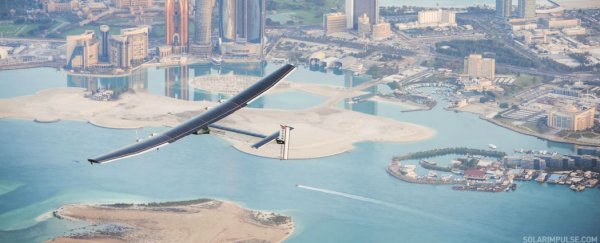Swiss pilots are about to embark on a 35,000-kilometre, five-month journey around the world in their little, solar-powered plane. Absolutely no fuel required.
This proof of concept voyage will begin and end in Abu Dhabi, being split into 12 legs, each one spanning 25 flight days. Why is it going to take so long? Well, the journey is by no means going to be very fun for the pilots.They will end up spending around 250 hours in the cockpit, the temperature of which will be anywhere from -40 to 40 degrees Celsius at any given moment. Plus there's no heating or oxygen in the cock-pit, the single seat doubles as the toilet and the bed, and they will have to survive on 20-minute naps every two to four hours. So no wonder they're splitting this thing up into 25-day stints.
The plane itself, called Solar Impulse 2, has a wingspan larger than a Boeing 747, which is covered in more than 17,000 solar cells. These provide its electric motors and 633 kg cache of four lithium batteries with enough power to get it through the night, and any cloudy days that might crop up, at a constant speed of around 140km/h. The plane has already broken the record for being the first entirely solar plane to fly between continents, and if it can make this journey to the end, it'll be the first solar-powered plane to circumnavigate the globe.
Will this change the way we fly in the near future? Not likely, unless everyone suddenly decides that uncomfortable, super-slow air travel is something they'd really enjoy - Karl Mathiesen at The Guardian compares the plane's weight and speed to that of a Volvo sedan. But that's not what this journey is all about, as Chris Mills explains over at Gizmodo:
"The craft is unlikely to be breaking speed records any time soon, but to the minds behind the project, Swiss aviators Bertrand Piccard and André Borschberg, that's not the point. For them it's the energy efficiency of the project that makes it exciting. They're not so concerned with changing the aviation industry just yet, so much as changing the public perception about how exciting renewable energy can be. In other words, this is as much publicity stunt as technological milestone."
In one sense, it's a shame that people like Piccard and Borschberg have to go to great - and extremely uncomfortable - lengths in order to convince people of the incredible potential of renewable energy. All we really need to do is look at Germany, which is already quietly generating half its energy from solar power. But every little bit helps, so best of luck to the pilots and the Solar Impulse 2. We'll be watching you anxiously, every step of the way (while never again taking for granted the fact that our chairs, beds, and toilets are separate entities.)
Source: Gizmodo
